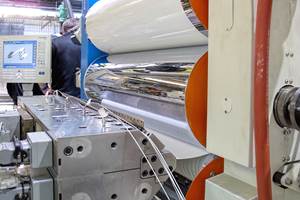A Relic of Plastics’ Rough and Ready Days
In 1955, Allied Resins and Allied Resinous Products were prosperous, creative compounding and extrusion operations, respectively, situated across the street from each other in Conneaut, Ohio.
In 1955, Allied Resins and Allied Resinous Products were prosperous, creative compounding and extrusion operations, respectively, situated across the street from each other in Conneaut, Ohio. Allied Resins compounding, founded by Ed Malek in 1946, helped move the toy industry from metal into plastics. One of its major customers was Louis Marx Toys in Erie, Pa. Allied also reprocessed several carloads a month of Western Electric’s wire and cable scrap into new PVC and PE compounds. Allied Resinous Products, founded by Ed’s brother-in-law, Keith Anderson in1951, extruded the very first vinyl garden hose (for Yardley in Columbus, Ohio) and the first Hula Hoops.
When interviewed a few years ago, Ed Malek (now deceased) recalled that the Hula Hoop job came from an acquaintance of then-sales manager William Hubbard, Jr. “Bill had a friend in Detroit who called one day and asked if we had any extruders that weren’t busy. He wanted hoops. We got the first order for 2 million lb of them, any color, and they took off. So we put several extruders onto making hoops. It didn’t last long, but for a while we filled railroad cars with them.”
Malek and Hubbard flew all over the Midwest in Hubbard’s single-engine Cessna to make sales calls. Allied Resins got the contract to reprocess and compound all the plastic coatings that Western Electric had stripped from used wire—five or six railcars a month of black cable scrap. Allied added red to the scrap and shipped the pellets across the street to be extruded into brown pipe.
Bob Lascak, a 30-year employee at Allied Resinous Products across the street, was hired as an electrical engineer and worked his way up to production manager. The plant specialized in heavy-gauge sheet for military applications. Lascak recalls visits to the compounding plant in the early days: “The PVC started as junk. They cleaned it with screen packs and extruded it as a big blob. They put that through a mill and rolled it into a kind of sheet, fed the sheet into the extruder and strand pelletized it. It was a smoky, smelly arrangement,” he recalls, “but it was compounding.”
Allied Resins started compounding with a short-barreled rubber extruder. Malek and Hubbard (who later started his own ´óĎó´«Ă˝ building small extruders) made the barrel longer and added heaters. “We wound up with a 6-in. extruder that was 16 ft long and looked like a cannon,” Malek recalled.
Under new owners
Malek retired in the mid-1970s and sold the compounding ´óĎó´«Ă˝ to a holding company, which later sold it to Polycom in Washington, Pa., which in turn was bought by Spartech Corp. of St. Louis. Keith Anderson sold the sheet extrusion plant in 1975 to Norton Co. in Akron, a maker of abrasives, which sold it to an individual named Louie Visaraga, who sold it in 2000 to
Spartech Plastics. Anderson came back every Christmas for 25 years and took all the old-time employees out to lunch.
Spartech continued to run the two plants as separate entities—compounding as part of Spartech Polycom, the sheet plant as part of Spartech Plastics. Each had about 50 employees.
But Spartech eventually decided that the Conneaut plants were too small and expensive to operate. In 2002 Spartech shut down the sheet plant and moved four big extrusion lines for heavy-gauge sheet to Spartech’s plant in Richmond, Ind. Lascak was one of a few Conneaut employees who was kept on for another six months to get the lines up and running in Indiana. Eventually, he was hired at Spartech Polycom in Conneaut. Then last March, Spartech closed that plant too.
Spartech is now selling the buildings formerly inhabited by Allied Resins and Allied Resinous Products to a PVC extrusion processor, but the deal had not closed at press time.
Editor’s Note: Senior editor Jan Schut is the daughter of William Hubbard, Jr., who was sales manager of the two Allied plants from the late 1940s to late ’50s.
Related Content
Making Gains in the Drain Game
AWD blends extrusion and thermoforming technologies with plenty of home-brewed equipment and processes to keep water away from where it isn’t supposed to be.
Read MoreExtrusion Excellence: This Year's Top Stories
Revisit the year’s most popular articles on extrusion technology and processes, showcasing innovations, best practices, and the trends that captured the plastics processing community’s attention.
Read MoreRoll Cooling: Understand the Three Heat-Transfer Processes
Designing cooling rolls is complex, tedious and requires a lot of inputs. Getting it wrong may have a dramatic impact on productivity.
Read MorePTI Seals Deal to Rep Italian Slitter Manufacturer Helios
PTi to provide slitters and related components and services to sheet processors in the U.S. and Canada under exclusive agreement.
Read MoreRead Next
Making the Circular Economy a Reality
Driven by brand owner demands and new worldwide legislation, the entire supply chain is working toward the shift to circularity, with some evidence the circular economy has already begun.
Read MoreFor PLASTICS' CEO Seaholm, NPE to Shine Light on Sustainability Successes
With advocacy, communication and sustainability as three main pillars, Seaholm leads a trade association to NPE that ‘is more active today than we have ever been.’
Read MorePeople 4.0 – How to Get Buy-In from Your Staff for Industry 4.0 Systems
Implementing a production monitoring system as the foundation of a ‘smart factory’ is about integrating people with new technology as much as it is about integrating machines and computers. Here are tips from a company that has gone through the process.
Read More












